Reader’s report: Kayaking and paddleboarding with your dog
I have long had a draft post about kayaking with a dog in my queue, waiting for content. I’m not a kayaker myself, and for many years the only text I had on an otherwise empty page was a note to put long-haired dogs in doggie t-shirts before strapping on their life vests, to avoid hair-pulling. It’s a great tip, from an experienced and adventurous friend with two Papillons, but one tip does not a post make. Just recently, however, this adorable video appeared in my Instagram feed:
httpv://m.youtube.com/watch?v=jf71vjXHwKk
I promptly wrote to Katherine, of @robinventures, and she kindly agreed to write a guest post for Dog Jaunt about kayaking and paddleboarding with Robin, her Basenji mix. I urge you to follow her Instagram feed — it’s delightful and inspiring. Over to Katherine!
“Robin’s an 18lb, 2.5 year old basenji mix, adopted from a local shelter in Los Angeles. Despite his small size, he’s an adventure dog — he loves hiking, camping, and more recently, paddle sports. Water’s scarce where we live, but Robin has kayaked at Salton Sea and in Sausalito, CA, and has gone paddleboarding at Pyramid Lake, CA and Lake Las Vegas. Though he’s not a natural water dog, paddling has increased his confidence on the water so much that on our most recent paddleboarding trip, he plunged in to swim between our boards multiple times! You can follow his adventures on Instagram @robinventures.
Paddling with your pup is a great way to enjoy the summer heat! Kayaking is an easy beginner activity, rentals are widely available at waterfront locations, and many dogs love it — or at least tolerate it. Paddleboarding is another water activity to consider — it takes a little more balance, but the wide deck can be great for larger dogs. Here are some tips to make your first water adventure a success.
If you’ve never paddled before, or you’re not interested in getting dunked, try kayaking first — it’s much more stable for you (and a novice pup). The wide sit-on-top kayaks common at rental places have plenty of space for your dog to ride in the front, and are easy to maneuver in calm lake and marina conditions. Sit-inside kayaks tend to be designed more for speed, and may not have enough space for a dog unless the deck is outfitted with grippy surface. Robin and I have only used the sit-on-top kind.
There’s enough room in the foot wells for most dogs, but nervous dogs may be uncomfortable with the slick surface. On our first kayak trip, I put my bag in front of me for Robin to sit on. After that, he was much more confident, and moved between my lap and the prow of the kayak depending on our speed.
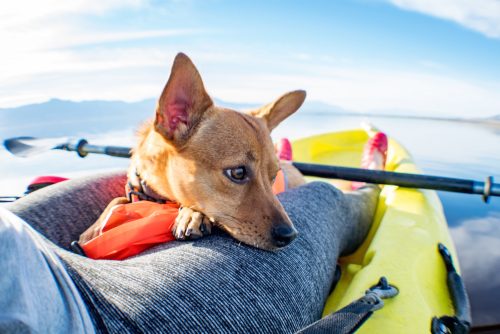
Robin curled up in Katherine’s lap
If you choose to paddleboard, there will be plenty of space, but depending on the board’s material and shape, the front half may be too slick for good paw traction. If your dog is bothered by the surface, have him ride behind you — it’s easier to paddle that way anyway. Consider your dog’s weight and the amount of maneuverability you want to have when picking a board — larger boards will ride higher and be more stable, but they’ll be harder to turn.
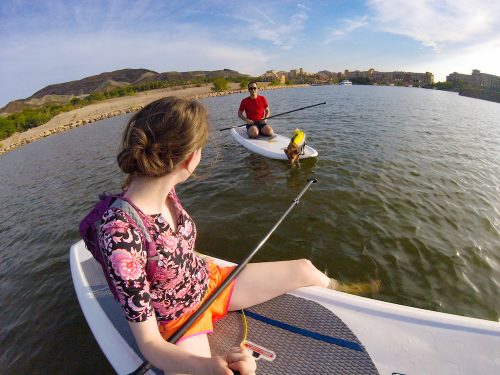
This pair of photos totally charms me — there’s Robin, on Katherine’s companion’s paddleboard, eying her longingly…
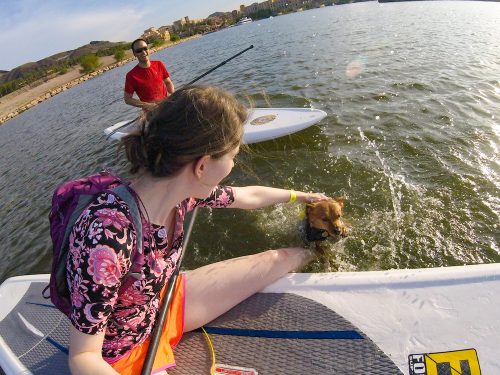
…and here he comes.
Before trying a paddle sport, make sure your dog has a good “stay.” A big leap can destabilize you, especially on a paddleboard. Until our most recent trip in Las Vegas, I didn’t have to worry about Robin jumping into open water (he’s now heady with his own success and quivers on the edge of the board waiting for permission), but his premature bid for shore on our first trip dunked us both. Those with fearful swimmers should bring along treats or a toy to create positive associations. Also, make sure to bring drinking water and a travel bowl on board. Fresh water lakes can contain parasites and bacteria, and dog fatalities are often the first indicators of a toxic algae bloom.
You should WEAR a life jacket your first time paddling with the pup, until you know how he’ll react to the trip. If you fall in, your first priority will be getting to your flailing dog, not snagging a PFD as it floats away, and if your panicking dog climbs you, treading water is much more difficult.
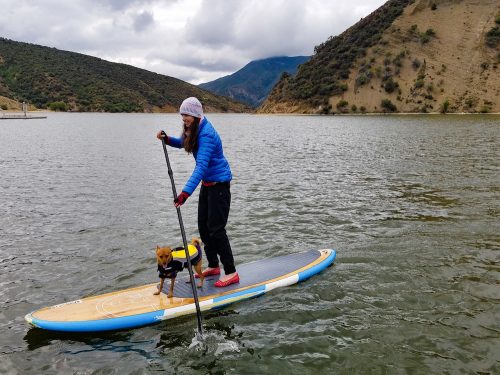
Paddleboarding together — Katherine was thrilled to report that Robin’s becoming ever more comfortable with being onboard.
Outfit your pup with a handle-equipped life jacket, and make sure it fits properly before heading out. While most dogs can swim, treading water isn’t a natural exercise for them and they can panic when they slip into the open water. Loose fitting life jackets can ride up and trap the dog’s front paws as they panic paddle, rendering them a hindrance rather than a help. We use a life jacket from Alcott, which has a flexible neoprene belly panel for comfort during lifting. Unfortunately, we didn’t have it for our spontaneous kayaking trips, so we used his handle-equipped Ruffwear harness.
Consider carefully before leashing your dog to yourself or the boat, and if you do so, clip the leash to the life jacket, never to a collar. There’s still a risk that the leash could wrap around the dog’s neck in a fall, or that it could snag on the watercraft, trapping him underneath. In the case of an upset, your dog is likely to swim either to the board/kayak or to you, so you shouldn’t need to worry about reeling him back in. I keep a waist leash handy, but I no longer attach it to Robin.
Even water-loving dogs can get nervous when they’re out in open water, so be prepared with praise and treats. Robin’s desire to be with me outweighs the fear of new experiences, but he was extremely nervous on our first trip. If possible, familiarize your dog with the boat gradually on shore, and definitely avoid lifting him in against his will. That life jacket handle is for helping the pup out of the water, not forcing him to board. If your dog is at all willing to swim, take some time to teach him to swim directly to the person, not to the nearest edge of the board, since he’ll need your assistance to get back up. And if your pup is anxious on the first trip, there’s hope! Over time, Robin has become so confident that he’ll happily plunge off the paddleboard to swim to a neighboring board.”
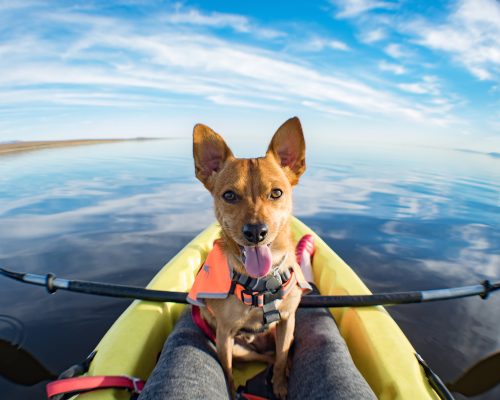
Happy dog, beautiful surroundings.
My heartfelt thanks to Katherine for writing such a thoughtful and useful post. I really like her emphasis on safety, and on making sure that everyone involved is having an equal amount of fun, and no one is being pushed beyond their comfort level. I’m looking forward to seeing ever more pictures of Robin on the water in the @robinventures Instagram feed!




